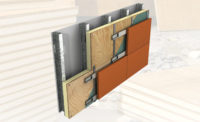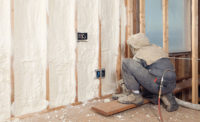In the past 30 years, the number of injuries and deaths caused by non-residential fires has dramatically decreased. During the same time span, the average amount of energy used per square foot in commercial buildings has also decreased. These reductions are due in part to the development of building codes aimed at minimizing fire risks and increasing energy efficiency in new commercial construction. Building professionals need to take special care in selecting the right insulation products to meet these two requirements.
On one side of the equation, both ASHRAE 90.1, Energy Standard for Buildings Except Low-Rise Residential Buildings, and the International Energy Conservation Code require continuous insulation in most U.S. climate zones. The continuous insulation layer is to enhance the building envelope’s energy efficiency by reducing heat loss through wall studs and other thermal bridges between conditioned spaces and the building’s exterior.
While the code requirements for continuous insulation help to improve efficiency, they raise another challenge: the foam plastic insulations commonly used for continuous insulation—polyisocyanurate aka polyiso, expanded polystyrene also known as EPS, extruded polystyrene aka XPS and spray polyurethane foam or SPF—are combustible. As with other combustible materials used in wall assemblies, these insulations must pass NFPA 285, Standard Fire Test Method for Evaluation of Fire Propagation Characteristics of Exterior Non-Load-Bearing Wall Assemblies Containing Combustible Components.
NFPA 285 in Short
The scope of NFPA 285 reads:
“This test provides a method of determining the flammability characteristics of exterior, non-load-bearing wall assemblies/panels. The test method described is intended to evaluate the inclusion of combustible components within wall assemblies/panels of buildings that are required to be of non-combustible construction. It is intended to simulate the tested wall assemblies’ fire performance.”
With limited exceptions, International Building Code Section 2603.5.5, Vertical and lateral fire propagation, requires wall assemblies in Type I, II, III and IV construction using foam plastic insulation to pass NFPA 285 testing requirements. Despite stating “non-load bearing” in its title and scope, NFPA 285 applies to both non-load bearing and load-bearing walls.
NFPA 285 is particularly rigorous in that it evaluates entire wall assemblies, not individual products within the assembly. Thus, even if a given insulation product – or other component – passes NFPA 285 in a specific assembly, that does not mean it is automatically compliant in alternate assemblies.
The NFPA 285 test of the wall assembly is comprehensive and includes everything from the structure outward to the cladding and inward to the drywall. Test results are “pass” or “fail” based on an evaluation of vertical and horizontal flame spread and conformance with temperature limits within the assembly.
Rigid Foam Insulation Options for NFPA 285 Compliant Walls
All of the foam plastic insulations discussed above have been used in NFPA 285 compliant wall assemblies, although their advantages in such applications differ. In addition, as the test is product specific, just because one particular brand and product line of polyiso, XPS, EPS or SPF passes the test does not mean that other brands of the same insulation have also passed the test in conjunction with the same components within the wall assembly.
When evaluating rigid foam plastic insulations for NFPA 285 wall assemblies, the following are key points to consider. Note, SPF insulation options that are NFPA 285 compliant also are available, but are beyond this article’s focus on rigid foams, so confirm with the manufacturer.
Polyiso
Manufacturers offer numerous polyiso product options, including multiple facers and composite panels, among others that have passed NFPA 285 testing. Base walls include steel frame, concrete masonry units, concrete and fire retardant treated wood stud wall assemblies, with a wide range of cladding types and weather barriers. Polyiso offers the highest R-value per inch of rigid foams, so it can help create thinner profile, NFPA 285 compliant wall assemblies than is possible with XPS and EPS. One product option, Hunter Xci Ply, includes polyiso laminated to fire-treated plywood, which helps simplify exterior cladding installation by providing the full panel surface as an attachment point, while providing continuous insulation and passing NFPA 285 in numerous wall assemblies.
EPS and XPS
Both polystyrene-based rigid foam insulations—EPS and XPS—are available in a range of product compositions, with some of them being NFPA 285 compliant within assemblies using steel studs, concrete masonry units and concrete. However, there can be limitations on cladding, and special fire-protection detailing might be required with these products. For example, window and door header details are crucial to NFPA 285 compliance, and some materials, such as XPS, require complex fire-protective details like a steel angle and/or mineral wool safing on the underside of the window header to protect the insulation from flashover from a fire.
Conclusion
Although no single insulation type or brand is ideal in all instances, many polyiso brands have been tested for NFPA 285 compliance in a wide range of wall assemblies, so they meet fire safety requirements while providing code required continuous insulation. In addition to this energy efficient performance, polyiso products have demonstrated high moisture performance (i.e., low moisture risks) in all types of climates.
As there currently is no centralized directory of NFPA 285-compliant products, it is important to confirm testing with the insulation manufacturer.








Report Abusive Comment